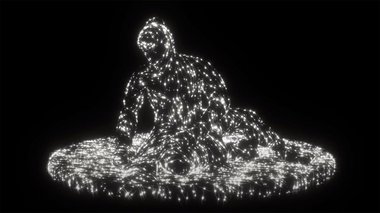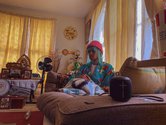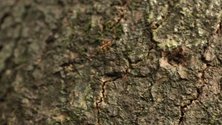John Hurrell – 11 May, 2021
Rangituhia Hollis' ongoing project, Across the face of the moon, reflects Teh's own approach by boldly putting formally differing sections, and normally unrelated subject-matters, varied fragments placed side by side so that the viewer can dig out conceptual connections. Join the dots that they insert themselves. (Pastrana is similar.)
Auckland
Rangituhia Hollis, Ana Iti, Alex Monteith, Sione Monu, Gary-Ross Pastrana
Sovereign Pacific / Pacific Sovereigns
Curated by David Teh
Works commissioned by Circuit
13 April -15 May 2020
Five extremely varied short films commissioned by Circuit—and which look at Pacific sovereignty—are here presented in Artspace Aotearoa’s downstairs cinema. They were selected for Circuit by David Teh, an academic and critic based in Singapore who has studied the growth of Thai art alongside the diminishing power of the Thai monarchy
The show’s title speaks of Pacific region-based political control, and also Pacific ‘gold’ coins; in other words, currency, or certain referenced oceanic countries linked to the five selected artists-and their influence.
It is a satisfying package with many internal connections between the five thematically very different works. Four are under twelve minutes and one is half an hour, yet the juxtaposition is not awkward. Four of the five are made in Aotearoa. The fifth is from the Philippines.
Rangituhia Hollis‘ ongoing project, Across the face of the moon, reflects Teh’s own approach by boldly putting formally differing sections, and normally unrelated subject-matters, varied fragments placed side by side so that the viewer can dig out conceptual connections. Join the dots that they insert themselves. (Pastrana is similar.)
Hollis juxtaposes a passionate and poetic voice-over (in darkness), with a split screen of moon and coloured text, silhouettes of talismanic animals and legendary heroes filled with white twinkling lights, moving coloured stencils of lions riding on the backs of flying birds carrying severed heads; and abstracted brightly-hued kitchen scenes where piecemeal architectures merges with the occasional face, cheese puff balls, levitating chips and other fried food.
The artist’s early voice-over eloquently speaks of alienation, despair and the chilling affects of colonialism, using a confronting tone with the oppressor: It is Us and Them…The We but not You… (Where the pilgrims circled the wagons)…Everybody is on the cusp of falling…Another Brown couple hits the dust…You will always get back up…We ain’t middleclass but we sure are practising…I decline to taste the casein air…[and later]…I look up to the Moon (I hear You whispering)…I wish for a home without You, The Listener.
The moon is also a striking image within Alex Monteith’s Deepwater Currents, a long multi-chaptered work that mixes footage of Facebook and Google pages, the artists’ editing console, turbulent coastal shots and ominous churning waves at two key surfing sites in Aotearoa and Ireland. Focussing on the ever-increasing height of waves and swell, and the accelerating speed of globally circulating thermohaline currents, Monteith also presents herself, fellow surfers and young family on boards in the water-along with mentioning ecological concerns about underwater cables, seabed mining permits and even the batteries of the cameras she uses.
With Monteith‘s much earlier projects I have always loved her films involving motorbikes, helicopters and planes, often because of her ultra-crisp (very physical) sound. The audio is good in Deepwater Currents too, but visually the work is super enticing and more structurally complex. Her cinematography of dripping eroded caves, remote sunlit beaches and dramatically tumbling water is exceptional.
Strangely Monteith’s shots of groups of surfers skimming across waves have a lot in common with Gary-Ross Pastrana’s inclusion of termite footage in Rewilding (a pun I think on ‘rewiring’, as well as referencing conservational restoration). Usually these creatures chomp away inside trees, turning wood to powder and are never seen, but we see a few outside in the open, with an entomologist providing commentary. There is an implication that they can get inside pianos, but that is never ever directly stated. Only vaguely hinted at, the also included instrument-maker and repairer concentrating on cutting into quality (uninhabited) timber in his workshop. There is also a musicologist who discusses the avant-garde music called Moment Form, and how disconnected fragments (that are not organic or growing from one part to another) are logically important without participating in a sequence. The ‘surprise factor’ within discontinuity is seen as a valuable benefit.
As for the termites, and their voracious eating of trees (which apparently are not that nutritious), they can be connected to Ana Iti’s use of blank paper to make improvised ‘stencils’ as Te Reo learning aids. In Howling out at a safe distance, her tearing by hand about a dozen paper sheets to make narrow horizontal holes serves as a sort of template for text-isolating, enabling investigative thought by being placed over the torn and stained pages of a fragile historic publication, and making a coincidental link to Pastrana’s social insects.
Her use of paper, a tree-based material (as a blocker-outer to enable focus, and as the hundred-year old Te Pipiwharauroa newspaper itself—named after the Shining Cuckoo) as a tool, allows her to vary the number of words in a phrase, vary the distance between two words, and be aware of the studied text’s position to the paper’s edge or spine. It is nice to hear the faint rustling sound of turning paper, and see the wit of her choosing, and seeking after, ‘searching,’ ‘conversational’ or ‘translational’ words like kimihia (to seek or hunt for), whakamāori (to interpret, elucidate or clarify), taha Māori (Māori perspective), or he kupu rurua aku (I have few words). Its explorative process hints of the excitement of a traveller starting an adventure.
Sione Monu‘s Only Yesterday also ponders the nature of looking, but this time the nature, not of learning a new language, but of love. With interviews and family photographs, it tells the story of two Tongan leiti living in Aotearoa. Fakaleiti are the Tongan version of the Samoan fa’afafine, boys chosen by the community to be raised as girls.
The two leiti are interviewed at home and on high hilltops in Mangere and the Auckland Domain, the vistas giving the discussion an air of positive optimism. Dressed in their finery (colourful woolly hats; distinctive headgear of hanging glass-bead strands; rhinestone bras; filmy slips; throat bands of glittering diamantes) the happy couple (who are exhibiting artists) chat chirpily about their love and hopes. ‘I’m looking for love and respect (not a husband).’ The theme is that of Pacific Islanders living in Aotearoa (in a new, often hostile, environment) aspiring to have happiness and effortless survival, and being treated with due dignity.
John Hurrell






 Two Rooms presents a program of residencies and projects
Two Rooms presents a program of residencies and projects Advertising in this column
Advertising in this column



This Discussion has 0 comments.
Comment
Participate
Register to Participate.
Sign in
Sign in to an existing account.